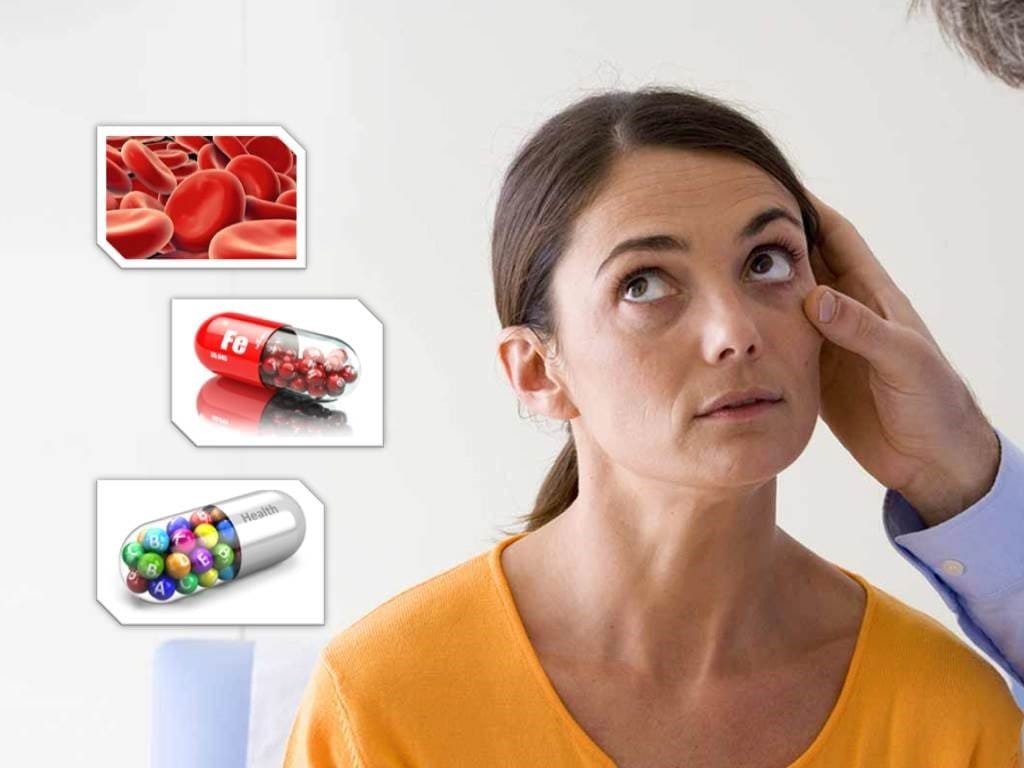Anemia in Women, Symptoms Causes and Treatment
What Is Anemia?
Anemia is a medical disorder that is characterized by a deficiency of healthy red blood cells or insufficient hemoglobin levels. You have a reduced ability to carry oxygen in your blood. Anemia can happen if you have less than normal red blood cells in your body. It can also happen if the hemoglobin (HGB) level in your red blood cells is below normal. Hemoglobin is a protein found in red blood cells that uses iron to carry oxygen from the lungs to the rest of the body. If you have anemia, your body does not carry enough oxygen in your blood to supply all the tissues in your body.
While there are several types of anemia, iron deficient anemia is the most common form, especially in women. This condition causes a decreased number of circulating red blood cells and also causes the size of the red blood cell itself to be much smaller. This results in a decrease in your body’s ability to carry oxygen to all of the billions of cells that require it.
Other types of anemia are associated with genetic disorders, deficiencies in vitamins, alcohol abuse, and chronic disease.
The Role of Red Blood Cells
Your blood comprises both red and white blood cells. Red blood cells carry oxygen, while white blood cells combat infections. Anemia can occur due to either a shortage of red blood cells (RBCs) or a lower-than-normal level of hemoglobin (HGB) in your red blood cells.
Hemoglobin (HGB): This protein utilizes iron to transport oxygen and gives blood its characteristic red color. HGB carries oxygen from the lungs to all parts of the body, fueling energy production and various bodily functions.
Anemia can manifest as mild, moderate, or severe, with varying durations. In cases of severe or long-lasting anemia, the lack of oxygen in the blood can harm vital organs such as the heart and brain, potentially leading to organ damage or even death. The positive aspect is that anemia can be diagnosed and effectively treated.
Prevalence of Anemia in Women
The World Health Organization (WHO) reports that over two billion individuals worldwide are affected by anemia, with women being more susceptible to this condition. In developing countries, the estimated prevalence of anemia is approximately 42% among women, 30% among men, and 45% among adults over the age of 60.
Symptoms of Anemia in Women
In its early stages, anemia may be so subtle that it goes unnoticed. Symptoms tend to worsen as anemia progresses, and common indicators include:
- Fatigue: Extreme tiredness, ranging from mild to severe.
- Breathing Difficulties: Feeling short of breath.
- Rapid Heart Rate: A fast heartbeat even when at rest.
- Pale Skin: Skin appearing lighter than normal.
- Paleness in Specific Areas: Lips, gums, eyelid linings, nail beds, and palms losing their usual pink hue.
- Feeling Cold: Sensation of coldness.
- Cognitive Issues: Confusion or difficulty concentrating.
- Dizziness or Fainting: Episodes of dizziness or fainting.
- Sadness or depression
Causes of Anemia
Anemia can result from various factors, including:
- Iron Deficiency: Frequently due to excessive blood loss during heavy or prolonged menstrual periods, frequent nosebleeds, or gastrointestinal bleeding. This type is known as “iron deficiency anemia.”
- Inadequate B Vitamins: Low levels of the B vitamin folic acid (folate) can lead to anemia, and a deficiency in vitamin B12 is termed “pernicious anemia.”
- Blood loss : In cases of bleeding from heavy menstruation , fibroids, miscarriage or other abnormalities of gastro intestinal or urinary systems .
- Opportunistic Infections (OIs): Several OIs associated with HIV can contribute to anemia.
- Kidney or Bone Marrow Damage: Damage to the kidneys or bone marrow can disrupt red blood cell production.
- Thyroid Conditions: Certain thyroid issues may affect weight regulation and contribute to anemia.
- Medications: Some drugs used in HIV and related infections can lead to anemia.
- HIV Impact: HIV can hinder the production of red blood cells in the bone marrow.
- Chronic diseases: conditions like crohn disease ,systemic lupus erythematosus, rheumatoid arthritis and ulcerative colitis can cause anemia of chronic diseases
- Alcohol abuse: Chronic alcohol use can cause vitamin B and folate deficiencies leading to anemia
Anemia in Women
Women are especially likely to develop anemia for several reasons, most important being heavy Periods and Pregnancy. According to the Centers for Disease Control and Prevention (CDC) in US , close to six million women between 15 and 49 years old are iron deficient, and almost half of these women are likely to develop iron deficiency anemia. Globally, iron deficiency is the most common nutritional deficiency and has negative effects on both women and children.
Anemia and Periods
Women between 12 to 49 years of age lose blood approximately once a month during their periods. Women who experience heavy bleeding during their periods, bleeding between periods, or women with certain conditions like uterine fibroids are at a higher risk for anemia. If you have any of the symptoms of anemia, especially coupled with dysfunctional uterine bleeding, your doctor will want to do a thorough physical exam and draw labs to determine if you are anemic.
Anemia in Pregnancy
Mild anemia is common during pregnancy due to increased blood volume. However, severe anemia can pose risks to your baby’s future anemia, and if you’re significantly anemic in the first two trimesters, you face a higher likelihood of pre-term delivery, low birth weight, and increased susceptibility to infections. During pregnancy, your body undergoes significant changes. Many women experience insufficient iron levels during the second and third trimesters, potentially leading to anemia when your body’s iron demand surpasses its supply. The volume of blood in your body increases by approximately 40%, resulting in higher iron and vitamin demands required for hemoglobin production. pregnant women require extra iron to support their baby’s proper development. During pregnancy, women need 50 percent more iron than usual (27 mg daily instead of the standard 18 mg). Dietary iron is often not enough to meet both mother and baby’s demands. Women also lose blood during childbirth. It is important for women who are planning to become pregnant or already are pregnant, to have their iron levels checked and bring any symptoms of anemia to their doctor’s attention. Your iron levels will be checked at your first prenatal visit and again at 28 weeks to make sure you aren’t deficient in iron. Make sure your prenatal vitamin has iron in it; if not, talk to your doctor about which prenatal vitamin you should use or if additional supplementation may be necessary. If you begin to have cravings for non-food items, like detergent, clay, or dirt, or begin to want to chew ice, this is a sign of significant iron deficiency and you must call the clinic immediately. Even though you may crave these items, do not eat them as they can be harmful to both you and your baby.
Risk of Anemia During Pregnancy
Several factors increase your risk of anemia during pregnancy:
- Close Pregnancy Intervals: Having pregnancies in quick succession.
- Multiple Pregnancies: Being pregnant with more than one child.
- Morning Sickness: Frequent vomiting due to morning sickness.
- Insufficient Iron Intake: Not consuming an adequate amount of iron-rich foods.
- Heavy Menstrual Flow: Having a heavy menstrual flow before pregnancy.
Symptoms of Anemia in Pregnancy
The symptoms of pregnancy-related anemia often overlap with those you might experience even if you aren’t anemic. These include:
- Fatigue or weakness
- Progressive paleness of the skin
- Rapid heartbeat
- Shortness of breath
- Difficulty concentrating
Doctors typically conduct tests to assess your red blood cell percentage and hemoglobin levels, helping identify your risk of developing anemia.
Complications
If iron deficiency anemia is left untreated, it can make you more susceptible to illness and infection, as a lack of iron affects the body’s natural defense system (the immune system). Severe iron deficiency anemia can increase the risk of developing complications that impact the heart or lungs, such as an abnormally rapid heartbeat (tachycardia) or heart failure, where the heart struggles to pump blood effectively at the correct pressure. Pregnant women with severe or untreated anemia are also at an elevated risk of complications both before and after childbirth.
Preventing Pregnancy-Related Anemia
Adequate nutrition is the key to preventing anemia during pregnancy or when trying to conceive. Incorporating iron-rich foods into your diet, such as dark green leafy vegetables, red meat, fortified cereals, eggs, and peanuts, can help ensure your body has a sufficient iron supply for proper functioning. Your obstetrician may also prescribe vitamins containing iron and folic acid to supplement your dietary intake. Aim for a daily iron intake of at least 27 mg. In case you do become anemic during pregnancy, it’s typically treatable with iron supplements.
Discuss your anemia risk with your doctor and ensure you are tested during your initial prenatal visit. You may also consider testing four to six weeks after delivery. Depending on your condition, your doctor may refer you to a hematologist, a specialist in blood disorders.
Diagnosis of Anemia
The effects of anemia can be significantly mitigated through early diagnosis and treatment. Typically, anemia is diagnosed by assessing hemoglobin and hematocrit (HCT) levels, with hematocrit representing the percentage of red blood cells in the bloodstream. These parameters are typically evaluated as part of a standard blood test known as a complete blood count (CBC). It is advisable to include a CBC as a routine component of your regular health check-ups.
- Hemoglobin (HGB) levels for women should be about 12 grams per deciliter (g/dL) – Hemoglobin level of less than 6.5 g/dL is very dangerous and could be life-threatening.
- Hematocrit levels for women should be 35 percent to 46 percent.
Anemia Treatment
The treatment approach depends on the underlying cause of anemia:
- Bleeding Cause: Identifying and managing the source of bleeding is crucial.
- Iron Deficiency: If you have low iron levels, your doctor may suggest ways to increase the amount of iron in your blood. You can change your diet to include foods rich in iron. Iron is found in dark, leafy greens (spinach, collards, kale, chard), beans (lentils, chickpeas, soybeans), red meat, seafood (clams, mollusks such as oysters, scallops), and fortified bread and cereals. Taking iron supplements can also raise levels. Consult to your doctor before taking extra iron. Iron can be given in the form of oral tablets ,intra muscular or intravenous injections.
- Folic Acid Deficiency: If you have low folic acid levels you can add foods that contain folic acid to your diet. Folic acid is found in dark, leafy greens, beans (e.g., lima beans, black beans, chickpeas, lentils), asparagus, citrus fruits (grapefruits, oranges, lemons, limes), and beef liver. You can also take folic acid tablets. Folic acid is particularly important for pregnant women; taking appropriate amount of folic acid (recommended: 400 micrograms/day) can help prevent birth defects in a baby’s brain and spinal cord. Folic acid holds particular significance for expectant mothers.
- Vitamin B12 Deficiency: If your vitamin B12 levels are low, you may require B12 injections or sublingual forms due to potential absorption issues. Strict vegetarians and vegans may be at risk of low vitamin B12 levels and might need liquid B12 supplements.
- Medication-Induced Anemia: If a medication is the culprit, it may need to be discontinued. However, always consult your healthcare provider before discontinuing any medication.
- Advanced HIV-Related Anemia: Treating HIV can alleviate symptoms.
- Medications for RBC Production: Some medications, such as erythropoietin (EPO), administered via injection, can stimulate red blood cell production. In severe cases, a blood transfusion might be necessary, though it’s typically reserved for urgent situations or when other treatments prove ineffective.
Consulting your healthcare provider will enable them to determine the most suitable treatment based on the underlying cause of your anemia.
Iron Supplementation
Your doctor may recommend that you supplement your normal diet with over the counter iron supplementation. This supplement should be taken with vitamin C containing foods or drinks (like orange juice) as Vitamin C helps the body absorb iron more efficiently. Iron supplements may lead to side effects such as constipation, nausea, and the darkening of stool color. You may need a stool softener or need to increase your fiber intake while your body adjusts to the supplement. It’s advisable to avoid consuming caffeine with meals as it can hinder iron absorption.
Taking Care of Yourself
Anemia is a common condition, especially women. It can result in feelings of fatigue, lower the quality of life, and an elevated risk of pregnancy complications . If you are feeling tired for unexplained reasons or experiencing any of the other symptoms listed above, talk to your doctor. He or she can conduct tests to ascertain whether anemia is the issue. If so, your doctor will look for the cause and suggest treatment options.










